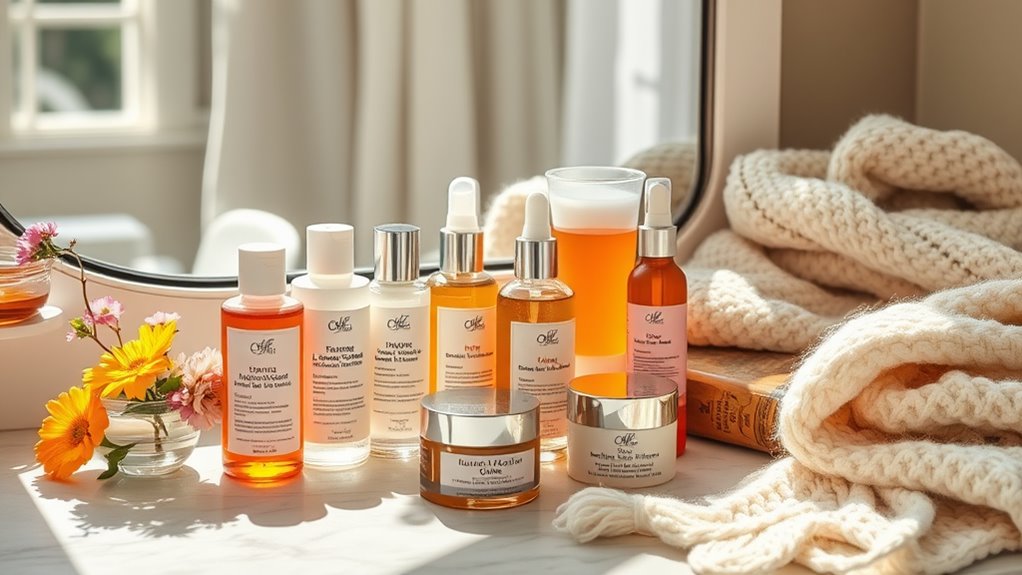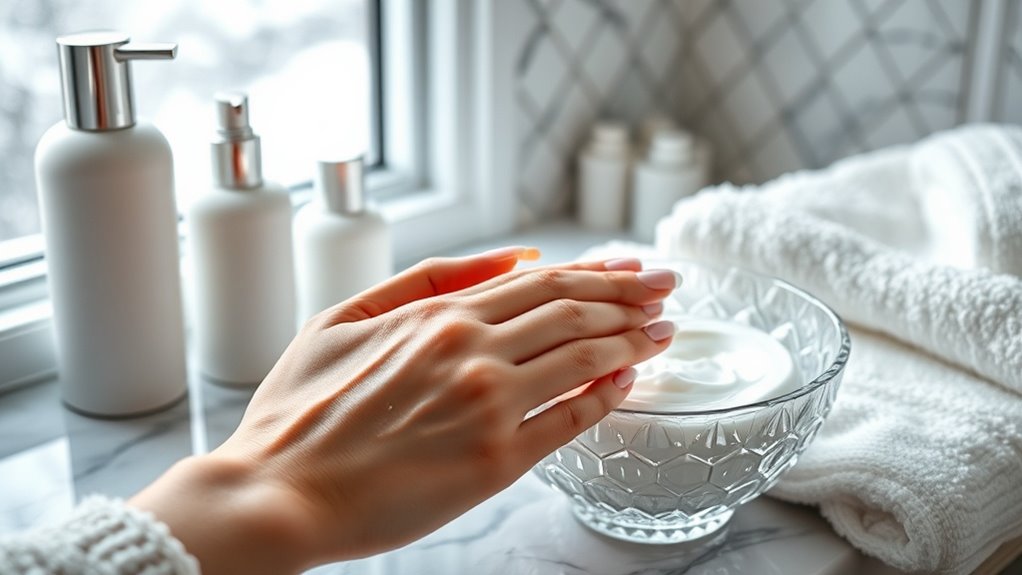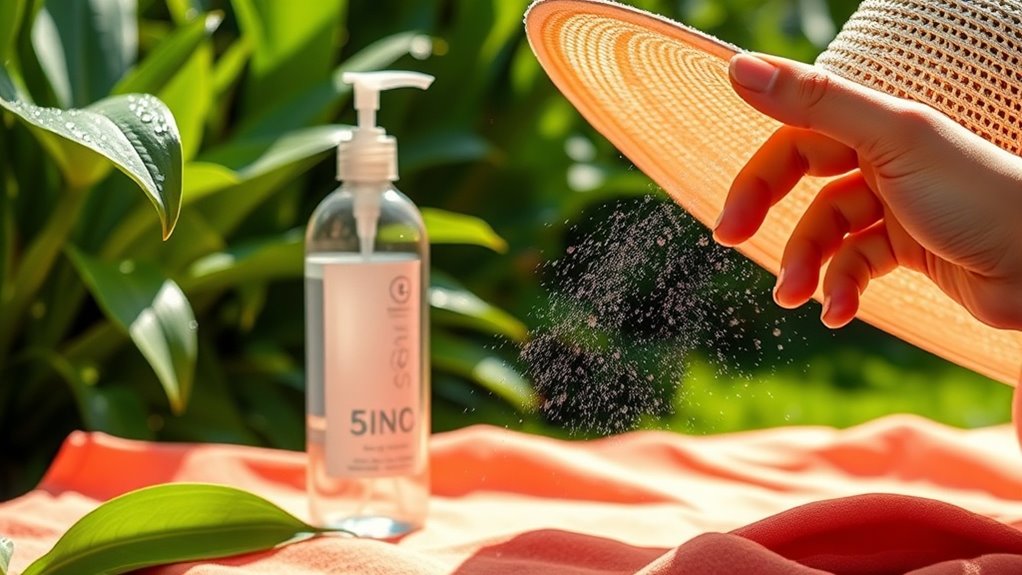How My Skincare Routine Changes With the Seasons
As seasons shift, you’ll adapt your skincare routine to keep your skin healthy and resilient. In spring, switch to lightweight moisturizers and hyaluronic acid for refreshed hydration against pollen. Summer demands daily broad-spectrum SPF 30 sunscreen, reapplied hourly, plus protective clothing to combat UV damage. For fall, boost moisture with ceramides and humidifiers to counter dryness. In winter, layer heavy, oil-based creams to lock in hydration. Dive deeper into these strategies for year-round glow.
Spring Skincare Refresh
As spring emerges, revitalize your skincare routine to adapt to warmer weather and rising pollen levels.
For effective seasonal skincare, switch to lightweight moisturizers and incorporate anti-inflammatory ingredients like chamomile to soothe irritation from pollen.
Gently exfoliate twice weekly to promote cell turnover, while boosting hydration with hyaluronic acid to maintain your skin’s barrier against environmental stressors, ensuring a balanced, radiant complexion. Additionally, consider how seasonal skincare routines can significantly impact your skin’s health and appearance.
Summer Protection Strategies
With summer’s intense UV rays posing significant risks, you must prioritize daily sunscreen application—opting for at least SPF 30 with broad-spectrum coverage—to shield your skin from burns, premature aging, and potential cancers, as supported by dermatological research. Beyond that, you’ll wear protective clothing and seek shade, reapplying sunscreen hourly during activities, per expert guidelines, to minimize damage effectively. Additionally, seasonal skincare adjustments can enhance your skin’s resilience against the harsh effects of summer.
Fall Routine Adaptations
As fall sets in, you’ll need to prioritize a hydration boost in your routine to replenish moisture lost from cooler, drier air, backed by dermatological studies showing increased skin barrier vulnerability. This means incorporating richer creams and serums that deliver essential fatty acids and humectants for best results. Additionally, enhancing barrier protection becomes vital, as research highlights its role in defending against pollutants and seasonal shifts that can compromise your skin’s natural defenses. To further support your skin, consider products that are specifically designed for seasonal skincare adaptations, as they can help maintain optimal moisture levels throughout the year.
Hydration Boost
How can you boost hydration in your fall skincare routine?
Fall’s cooler, drier air depletes your skin’s moisture, so incorporate hyaluronic acid, which studies show can retain up to 1,000 times its weight in water for deeper hydration.
Layer with a rich, non-comedogenic moisturizer and use a humidifier indoors.
Also, increase water intake; research confirms it supports skin’s natural hydration levels for a plump, resilient complexion.
Barrier Protection
Fall’s cooler winds and lower humidity can weaken your skin’s protective barrier, making it prone to irritation and dryness.
To fortify it, you’re incorporating ceramides and hyaluronic acid into your routine, as studies show these restore lipids and lock in moisture.
Opt for a thicker night cream and avoid harsh exfoliants; this evidence-based approach keeps your skin resilient through fall.
Winter Moisture Boost
As winter sets in, you must prioritize winter hydration essentials like humectants and occlusives to combat the season’s drying effects.
You’ll strengthen your skin’s moisture barrier by applying protective layers that seal in hydration, drawing from dermatological studies on environmental stressors. Incorporating effective winter skincare tips into your routine can enhance skin resilience against harsh conditions.
These steps guarantee your routine remains effective against cold-weather damage.
Winter Hydration Essentials
Winter often strips your skin’s moisture due to cold air and indoor heating, so you’ll want to prioritize hydration essentials that deliver a moisture boost.
Incorporate hyaluronic acid serums, which clinically attract and retain water in the skin, and apply them twice daily.
Choose heavy, oil-based moisturizers with glycerin for sustained hydration, as studies confirm they reduce dryness and improve barrier function without over-relying on repairs.
Moisture Barrier Tips
Enhance your skin’s moisture barrier to effectively combat winter’s drying effects.
Opt for ceramide-rich creams to repair and fortify it, drawing on dermatological studies showing their efficacy.
Layer hyaluronic acid serums for hydration, then seal with occlusives like petrolatum.
Use a humidifier, avoid hot water, and gently exfoliate weekly to minimize transepidermal water loss, ensuring resilient, plump skin.
Seasonal Product Transitions
Adapting your skincare products with the seasons helps maintain healthy skin by addressing shifts in humidity, temperature, and UV exposure. This approach optimizes your routine for year-round resilience.
- In winter, switch to richer emollients like ceramide creams to combat dryness and restore the barrier. Incorporating winter skincare hacks can further enhance hydration and protection during this season.
- During summer, opt for lightweight, hydrating gels to manage oiliness without clogging pores.
- In spring, incorporate targeted serums with hyaluronic acid to balance fluctuating moisture levels.
- For fall, add vitamin C products to shield against increased environmental stressors and promote repair.
Technique Tweaks for Changing Weather
As weather patterns shift, you must tweak your skincare techniques to protect and nourish your skin effectively.
In colder months, you gently exfoliate to remove dead skin without stripping natural oils, backed by research showing improved barrier function.
For humid seasons, you opt for lighter applications to avoid clogging pores, as experts advise for acne prevention.
Always pat dry to preserve moisture.





